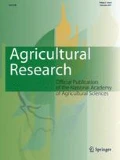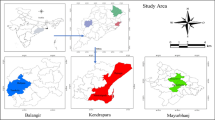Abstract
India, being the largest producer, consumer and importer of pulses, its demand and supply influences global pulses sector significantly. For several years, there has been consistent import of different types of pulse-grains by India, despite having the largest area under cultivation and their total production. This paper focuses mainly on the production of pigeon pea, second most produced and consumed pulse after chickpea. There has been a major shift in the pigeon pea production in the country. The study is an attempt to examine the adoption of modern variety and other production practices in the highest pigeon pea producing state of India viz. Maharashtra. The marketing behaviour of the pigeon pea growers is also the focus area of this study. The pigeon pea production in India varied dramatically over the last five decades, in terms of its spread, productivity and its importance as an intercrop. At the farmers’ level, there is a need for proper intervention in cropping patterns through new and improved crop varieties, information dissemination to farmers, mechanization and service support in reducing operational costs of farmers so as to increase the profitability from pigeon pea cultivation. The lot size and conveniences in terms of distance and time flexibility are some of the major influencers to decide about the marketing destination for the pigeon pea growers in the region.





Source: Directorate of Economics and Statistics, Government of India


Similar content being viewed by others
Notes
Agricultural Produce Market Committee (APMC) regulates the transaction of agricultural commodities in India, with its network of more than 7000 regulated APMC mandi (as on 31.3.2012). Most of these regulated markets are wholesale markets. Besides, the country has 22,505 rural periodical markets also, about 20% of which function under the ambit of regulation.
References
Akibode S, Maredia M (2011) Global and regional trends in production, trade and consumption of food legume crops. SPIA, March 2011. http://impact.cgiar.org/sites/default/files/images/Legumetrendsv2.pdf. Accessed 5 Dec 2016
Bai J, Perron P (1998) Estimating and testing linear models with multiple structural changes. Econometrica 66(1):47–78
Bantilan MCS, Joshi PK (1996). Returns to research and diffusion investments on wilt resistance in pigeon pea. Impact series no. 1. International Crops Research Institute for the Semi-Arid Tropics (ICRISAT), India
Bhosale J (2015). India set to import tur dal from Africa amid high domestic prices. The Economic Times, 19 Aug 2015
Department of Agriculture and Co-operation (2012) Report of expert group on pulses, DAC, Ministry of Agriculture, Government of India
Department of Agricultural Cooperation and Farmers Welfare (2017) Commodity profile for pulses. DAC-FW, Ministry of Agriculture, Government of India. http://agricoop.nic.in/sites/default/files/Pulses.pdf. Accessed 2 Feb 2017
Directorate of Economics and Statistics (2015) Agricultural statistics at a glance 2015. DES, Ministry of Agriculture and Farmers Welfare, Government of India
Desai P (2016). Pulses—all roads lead to India. Pulses Handbook 2016. CommodityIndia.com, pp 50–52. http://commodityindia.com/publication/pulses/article14.html. Accessed 5 Feb 2017
Dharmaraj PS, Lohithaswa HC (2004) ICPL-87119 (Asha): Fusarium Wilt and Sterility Mosaic disease resistant pigeon pea variety for northern Karnataka. Karnataka J Agric Sci 17(2):330–331
Economic and Political Weekly Research Foundation (2007–2008) Agricultural credit in India: changing profile and regional imbalances. Mumbai, India
Fan S, Brzeska J, Keyzer M, Halsema A (2013) From Subsistence to Profit: Transforming Smallholders Farms. Food Policy Report, International Food Policy Research Institute, Washington, DC
FAO (2016) FAOSTAT statistical database, Food and Agriculture Organisation of the United Nations. http://www.fao.org/faostat/en/#data/QC. Accessed 5 Dec 2016
Gowda CLL, Srinivasan S, Gar PM, Saxena KB (2013) Enhancing the productivity and production of pulses in India. In: Shetty PK, Ayyappan S, Swaminathan MS (eds) Climate change and sustainable food security. National Institute of Advanced Studies, Bangalore, pp 145–159
ICRISAT (1993) Pigeon pea variety ICP 8863. Plant Material Description No. 44. International Crops Research Institute for the Semi-Arid Tropics, Patancheru, Telangana, India
Inbasekar K, Roy D, Joshi PK (2015) Supply-side dynamics of chickpeas and pigeon peas in India. IFPRI discussion paper 01454. International Food Policy Research Institute, South Asia Office, New Delhi
Joshi PK, Kishore A, Roy D (2016) Making pulses affordable again: policy options from the farm to retail in India. IFPRI discussion paper 01555, IFPRI South Asia Office, New Delhi
Kannaiyan J, Nene YL, Reddy MV, Ryan JG, Raju TN (1984) Prevalence of pigeonpea diseases and associated crop losses in Asia, Africa and the America. Trop Pest Manag 30:62–71
Kathmale DK, Dhadge SM, Satpute NR, Patil SV, Chary GR, Rao CS, Jadhav JD, Kadam JR (2014) Evaluation of pigeonpea (Cajanas cajan L.) based intercropping system under semi-arid vertisol in scarcity zone of Maharashtra. Indian J Dryland Agric Res Dev 29(1):27–34
Kelly TG, Rao PP (1993). Chickpea: a preferred pulse? ICN 28. http://oar.icrisat.org/2775/1/ICN28%25286-7%25291993.pdf. Accessed 24 Dec 2016
Naveen R (2016). Where are pulses prices headed? www.CommodityIndia.com. Accessed 26 Dec 2016
Negi A, Roy D (2015) The cooling effect of pulse imports on price: the case of pigeon pea in India. IFPRI discussion paper 01439. IFPRI South Asia Office, New Delhi
Poulton C, Macartney J (2012) Can public-private partnerships leverage private investment in agricultural value chains in Africa? A preliminary review. World Dev 40(1):96–109
Rajan R (2016). The changing paradigm for financial inclusion. Speech delivered at the National Seminar on “Equity, Access and Inclusion- Transforming Rural India through Financial Inclusion” organised by National Institute of Rural Development and Panchayat Raj, Hyderabad on July 18
Rao VG, Satyapriya VS (1983) Pulses: growth, regional distribution and area responses. Artha Vijnana 25(3):246–258
Rathod PS, Halikatti SI, Hiremath SM, Kajjidoni ST (2004) Comparative performance of pigeonpea based intercropping systems in northern traditional zone of Karnataka. Karnatak J Agric Sci 17(2):203–206
Reddy R, Tonalpi VA, Bezkorowajnyi PG, Navi SS, Seetharama N (2007). Seed system innovations in the semi-arid tropics of Andhra Pradesh. ICRISAT, Patancheru, India. ISBM 978-92-9066-502-1, p 224
Reddy AA (2009) Pulses production technology: status and way forward. Econ Polit Wkly 44(52):73–80
Reddy AA (2013) Strategies for reducing mismatch between demand and supply of grain legumes. Indian J Agric Sci 83(3):243–259
Reddy AA, Bantilan MCS, Mohan G (2013) Pulses production scenario: policy and technological options. Policy brief 26, ICRISAT
Ryan JG (1981) Estimation of the economic value of production losses due to diseases of pigeonpeas. In: Kannaiyan J, Nene YL, Reddy MV, Raju TN (eds) International survey of pigeonpea diseases. ICRISAT, Patancheru, Telangana, India
Subramanian A (2016) Incentivising pulses production through minimum support price (MSP) and related policies. Report by Chief Economic Adviser, Ministry of Finance, Government of India
Swaminathan MS (2016). Pulses and the zero hunger challenge. In: Dasgupta S, Roy I (eds) Keynote speech in proceedings of the regional consultation on the promotion of pulses in Asia for multiple health benefits. Food and Agriculture Organisation of the United Nations, pp 2–6
Waghmare A (2016) Make in Mozambique: pulses the real reason behind PM Narendra Modi’s visit. The Economic Times daily, 18 July 2016
Acknowledgements
The financial support received from CRP-PIM (CGIAR Research Program-Policy, Impact and Markets) in conducting the study is duly acknowledged. Authors express sincere thanks to all the field staffs, the field supervisors, data analysts and G.Ishitha, Young Professional for their assistance in carrying out this study.
Author information
Authors and Affiliations
Corresponding author
Rights and permissions
About this article
Cite this article
Kumar, R., Surjit, V. & Khan, P.E. Complexity in Technology Choices and Market Access for Pigeon Pea Growers in Semi-Arid Tropics of India. Agric Res 7, 360–372 (2018). https://doi.org/10.1007/s40003-018-0321-y
Received:
Accepted:
Published:
Issue Date:
DOI: https://doi.org/10.1007/s40003-018-0321-y




